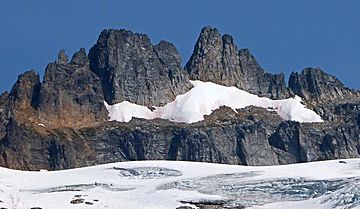Sharkfin Tower facts for kids
Quick facts for kids Sharkfin Tower |
|
|---|---|

Sharkfin Tower, south aspect
|
|
| Highest point | |
| Elevation | 8,120 ft (2,470 m) |
| Prominence | 80 ft (24 m) |
| Parent peak | Boston Peak (8894 ft) |
| Geography | |
| Parent range | North Cascades Cascade Range |
| Topo map | USGS Cascade Pass |
| Type of rock | Granite, Orthogneiss |
| Climbing | |
| First ascent | 1947 by Wesley Grande, Jay Todd, Joseph Vance |
| Easiest route | SE Ridge Climbing class 5.0 |
Sharkfin Tower is a cool mountain peak that stands tall at 8,120 feet (about 2,475 meters) in North Cascades National Park. You can find it in Skagit County, Washington state. It's part of the amazing North Cascades mountain range, which is a section of the larger Cascade Range.
This peak gets its name because it looks a bit like a shark's fin! It sits on a high ridge connecting two other big mountains, Forbidden Peak and Boston Peak. Below its southern side, you'll find the Quien Sabe Glacier, and a huge glacier called the Boston Glacier spreads out on its northern side.
Many climbers think Sharkfin Tower has some of the best granite rock for climbing in Washington. There are a few popular climbing paths. The Southeast Ridge was first climbed in August 1947. Another tough route, the Southeast Face, was first climbed in September 1990. The Northwest Face was first climbed on July 1, 1968. On July 10, 2005, a climbing group had a very serious accident while trying to reach the top. Water from Sharkfin Tower flows into the Cascade River and Thunder Creek, which then join the Skagit River.
Weather at Sharkfin Tower
Sharkfin Tower is located in a place with a "marine west coast" climate. This means it gets a lot of weather from the Pacific Ocean. Most weather systems travel from the Pacific Ocean towards the Cascade Mountains.
When these weather systems hit the tall peaks of the North Cascades, they are forced to rise. As the air goes higher, it cools down and drops its moisture as rain or snow. This is called "orographic lift." Because of this, the western side of the North Cascades gets a lot of rain and snow, especially in winter.
During winter, it's often cloudy. But in summer, high-pressure systems over the Pacific Ocean usually bring clear skies. Because the ocean influences the weather, the snow here can be wet and heavy. This can sometimes lead to a higher risk of avalanches.
How Sharkfin Tower Was Formed
The North Cascades area has some of the most rugged and dramatic landscapes in the Cascade Range. You'll see sharp, craggy peaks, long ridges, and deep valleys carved by glaciers. All these different shapes and huge changes in height happened because of geological events many, many years ago. These events also led to the different climates you find across the Cascade Range.
The story of how the Cascade Mountains formed goes back millions of years, to a time called the late Eocene Epoch. At that time, the North American Plate (a huge piece of Earth's crust) was slowly moving over the Pacific Plate. This movement caused a lot of volcanic activity. Also, small pieces of the Earth's crust, called "terranes," came together to form the North Cascades about 50 million years ago.
Later, during the Pleistocene period (which started over two million years ago), huge sheets of ice called glaciers moved across the land many times. As they moved, they scraped and shaped the landscape, leaving behind piles of rock. The U-shaped valleys you see in the rivers today were created by these glaciers. The combination of the land being pushed up (called "uplift") and cracks forming in the Earth's crust (called "faulting"), along with the work of glaciers, has created the tall peaks and deep valleys of the North Cascades area.




